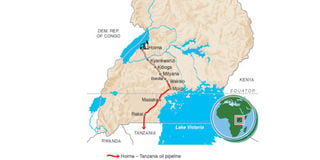Govt starts resettlement study on Hoima-Buloba oil pipeline

Proposed oil pipeline route
What you need to know:
Timeline. The project is expected to be complete by 2020.
Kampala.
Uganda and Tanzania have set a deadline of 2019/2020 to have concluded the construction of the crude oil pipeline.
This comes after the route from Hoima to the port of Tanga in Tanzania was adopted by the Uganda government two weeks ago.
One of the issues that come with the construction of the pipeline is land acquisition and since the entire corridor in Uganda is not public land, compensation of land owners and resettlement of families will be required.
The number of people and size of land required is not yet known as the Energy ministry has just started the study of land acquisition.
“This will be determined by the Resettlement Action Plan Studies for the Hoima-Buloba utility corridor. Government procured a consultant, Strategic Friends International, to develop and implement the Resettlement Action Plan for the acquisition of land for this infrastructure corridor,” Mr Ibrahim Kasita, the communications specialist in the Ministry of Energy and Mineral Development, told Daily Monitor recently.
According to Mr Kasita, the route in Uganda will traverse the districts of Hoima, Kyankwanzi, Kiboga, Mityana, Wakiso, Mpigi, Masaka and Rakai before crossing into Tanzania.
However, government is currently focused on first acquiring land between Hoima and Buloba in Wakiso District. This is because priority has been an oil refinery of 60,000 barrel of oil per day capacity in Kabaale, Hoima District.
The refined products will require a pipeline to a distribution point in Buloba, Wakiso District. The corridor for the refined products pipeline is the same the crude oil pipeline will follow but continue from Buloba to Uganda-Tanzania border.
One of the concerns raised about oil development in Uganda is the lack of infrastructure such as roads to transport the equipment to be used in the construction of oil refinery. The Kampala - Hoima road is narrow, with some sections dominated by potholes.
In the acquisition of land for the pipeline, the Energy ministry is looking at a corridor that can accommodate a road, a power line, fibre optic and communications cable and the pipeline.
“Government plans to acquire a utility corridor of 133 metres wide that will contain pipelines, a dual carriage highway, a communications cable and a power transmission line. Out of the 133 metres of the utility corridor, 38 metres are earmarked for the pipelines. The utility corridor will be approximately 210km long, from Kabaale, Hoima to Buloba near Kampala,” Mr Kasita said.
Other government agencies like the Uganda National Roads Authority, Uganda Communications Commission, and Uganda Electricity Transmission Company are expected to be brought on board once the land is fully acquired. The process is expected to be completed in the 2017/18 financial year.
The study
The Uganda government has so far concluded the routing and environmental baseline study conducted by Danish firm, M/s Ramboll and Ugandan firm NewPlan Ltd. This study included an ariel, geotechnical and geophysical tests like soil samples and digging of test pits. The findings of this study are expected to be presented in June 2016, according to the Energy ministry.




